The author has graciously shared with readers of the Victorian Web this passage from the second edition of her Fashion in Costume, 1200-2000 (2000), published by A & C Black (Publishers) Ltd., which retains copyright. Readers wishing to obtain the book can e-mail the following address: sales@acblack.com.
The cut of men's coats through this period changed from long sloping shoulders, tight waist and rounded hip to a straighter, longer-waisted, more masculine shape, and by 1875 shoulders began to be padded much as they are today. They were called at first 'American' shoulders, and probably originated there, as a feeling for more casual and easier-fitting clothes certainly did, although this influence only gradually found its way into Europe. The coat was often double-breasted, cut with waist and side body seams and frequently an added section under the arm, giving five seams in all, which allowed for considerable graduations of fit. The frock coat continued as the basic coat style, correct for formal day wear. During the 1870s -80s morning frock coats and dress frock coats seem to have been very similar, except that the latter opened low, exposing more of the shirt front than the former, with long narrow lapels faced with silk to the edge and often a narrow velvet collar. Silk facings and braid binding on collars and revers were extensively used from the 1860s-80s.
The morning coat and the frock coat
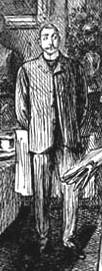
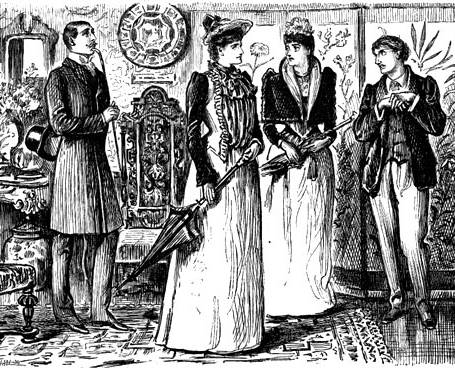
Left Morning coat. Right: Frock coat (at left) and a jacket. [Click on these images for larger pictures.]
During the 1870s-80s the morning coat, low-waisted, single-breasted, its skirt cut away from centre front, rivalled the frock coat; but the latter held its own, returning to high favour in the 1890s, and by the turn of the century these two coats, previously a riding coat and a casual country coat, were now correct for formal daytime wear.
The jacket, originally a garment worn by labourers, apprentices, postillions and the like and used by 18th-century gentlemen only when powdering, became acceptable in the 19th century as part of a gentleman's suit, replacing the coat for informal occasions. Already worn in the 1840s, it became increasingly popular from the 1850s on, varying a little in shape and known by various names. The lounging jacket from the very late 1840s was single-breasted and short-skirted, with rounded fronts, flapped pockets on the hips and a slit or welt pocket on the left breast; without the latter it might be referred to as an Albertjacket. During the 1860s the loungingjacket became part of the lounge suit -- trousers, waistcoat and jacket all made of the same material and acceptable for informal wear. The Tweedside, from 1858, was a loose, single-breasted jacket reaching mid thigh, with slit or patch pockets, a small collar, often short lapels, and buttoned high; often only the top button was used. A knee-length version was worn as an overcoat.
The reefer was double-breasted, cut to crotch level and square at the front, with three or four pairs of buttons; it had no back seam but vents in the side seams. The collar was small and flat, the lapels short. It was worn from 1860, sometimes as an overcoat, and by the 1890s was only fashionable as such. A similar garment was adopted by women and both male and female garments in dark blue serge were considered suitable for seaside wear.
The Norfolk jacket
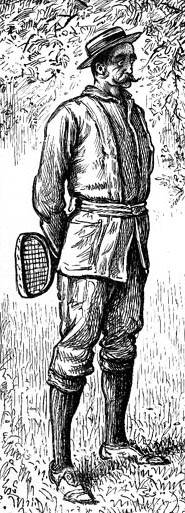
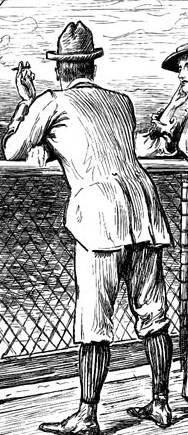
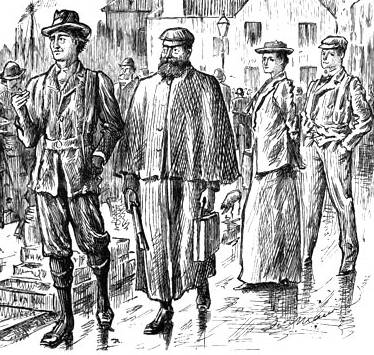
Examples of the Norfolk jacket. Not the different kind of jacket worn by the young man at the right in the right-hand picture. Note, too, five different kinds of men's hats. [Click on these images for larger pictures.]
Popular in the 1880s and also adopted by women was the Norfolk jacket, reaching mid thigh, single-breasted, buttoned high, with box-pleats down each forepart and at the centre back, large patch or bellows pockets on the hips and a belt of self material, usually Harris tweed or a similar fabric. An earlier version with shirt-like cuffs called the Norfolk shirt was worn from the mid'60s. In the 1890s thejacket might have a yoke from which the pleats would start. Eventually, with matching knickerbockers, it became the Norfolk suit and was much in evidence for shooting and informal country occasions. About 1888 it replaced the patrol jacket, hip-length, single-breasted, fastened high with a small or Prussian collar, worn with matching tight breeches for cycling during the 1870s. The university or angle-fronted jacket, also worn for sport between 1870 and 1880 or so, was single- or double-breasted, its fronts cut to form an opening exposing the waistcoat and the bottom of the front skirts cut into obtuse angles. By the 1890s cricketing and boating were enlivened by the blazer; originally a scarletjacket, it was later also made of other brightly-coloured cloth.
The tail or dress coat cut away across the waist
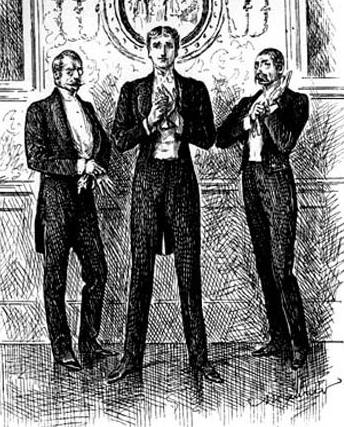

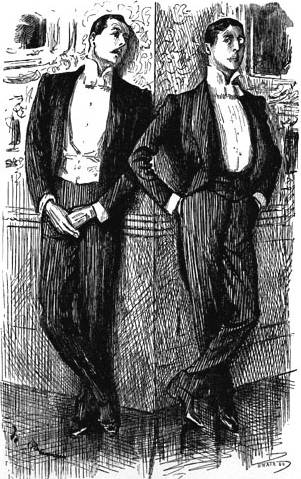
The tail or dress coat cut away across the waist, in fine black cloth with silk or velvet collar and facings, was worn on formal evening occasions only after 1860. The day coat of previous years was now relegated to the costume of indoor upper servants. By the late 1880s, following the daytime trend, a less formal evening coat was introduced; called at first a dress lounge, then a dinner jacket (or in America a tuxedo), it had a continuous roll collar turning low to waist level and faced with silk or satin, and one or two buttons (by the late 1890s only one), usually left open; it was fairly easy-fitting, the back cut whole, the sleeves often cuffed, with slit pockets on hips and left breast. It was increasingly worn at home or for dining at 'one's club'. If ladies were not present or had 'retired', a smoking jacket (introduced in the 1850s) was often worn; single- or double-breasted, usually made of velvet (though cashmere and plush were also used), it was ornamented with braid frogging and tassels in a military style and might be quilted for extra warmth. [140-41]
References
Nunn, Joan. Fashion in Costume, 1200-2000. 2nd edition. A & C Black (Publishers) Ltd; Chicago: New Amsterdam Books, 2000.
Last modified 11 June 2001